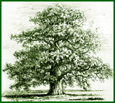DIGITAL PLASTIC SURGERY
Joelle Steele Preserves Faces From the Past
by Megan Marks-McKenzie
 There are more than many, many, many web sites dedicated to the pursuit of tracing ancestry and researching family histories. And what family history would be complete without photographs of family members and their earliest ancestors?
There are more than many, many, many web sites dedicated to the pursuit of tracing ancestry and researching family histories. And what family history would be complete without photographs of family members and their earliest ancestors?
While the Internet has made it easier to find information about our ancestors, it is still difficult to find well-preserved photographs of them. The materials used to create old photos makes them very fragile. If not handled and stored properly, they are subject to fading, discoloration, mold spots, water streaks, creases, scuffs, and tears – often with unattractive damage occurring to the face.
But, there's hope. Technology to the rescue. One family genealogist in Lacey, Washington has been digitally restoring unique, one-of-a-kind family photos and preserving faces from the past. In 1994, Joelle Steele, got a scanner, photo editing software, and was immediately hooked.
"I had all these great old family photos, but many of them were in terrible condition," said Steele. "I spent weeks – actually months – trying to learn how to scan them correctly and then fix the damage so that you couldn't tell I'd tinkered with them at all."
Steele soon discovered that scanning at high resolution was the most important step in the restoration process. High resolution means more pixels, those tiny squares of which digital images are made, and by working at the pixel level, Steele can make hundreds of changes to a photo, each so small that it is almost impossible to tell that a photo has been digitally manipulated. The fact that she is extremely fast and accurate with a mouse also proved to be a distinct advantage!
To date, Steele has digitally retouched and restored more than 2,000 antique photographs for other family genealogists, as well as for libraries, historic associations, museums, and other organizations that maintain photographic archives. In the process, she has also learned a great deal about the various antique photo processes, and has digitally restored hundreds of glass plate images, such as Daguerreotypes and ambrotypes. Many people try to scan glass plate negatives and tintypes, but scanning can damage these delicate images.
"Glass plates need to be photographed, not scanned, and that's a real challenge, since you're trying to fully capture a rather dark image from a highly reflective surface without using too much light," explains Steele. But she found a way to do it.
And then there are those photographs that need more than just mere restoration.
"I sometimes think of myself as a digital plastic surgeon," laughs Steele. "I have had to reconstruct a lot of ears and noses that went missing underneath large areas of damage." While she can often produce such digital miracles, it isn't always possible if there is insufficient image material with which to work.
Sadly, some photos simply cannot be fully restored. In most cases, it's due to images that were not that good to begin with. Old snapshots don't have a lot of detail because they were shot with inexpensive lenses. The same is true with old Polaroids, which additionally suffer from severe streaking due to their often haphazard self-processing methods. And some photos were over- or under-exposed when they were first taken.
"The best anyone can really hope for is that these types of images will be at least a little improved after being digitally retouched," says Steele.
Digitally repairing damaged photos is not all that can be done to improve their appearance. Color photos that have turned red can be color-corrected, and yellowed photographs can be returned to their original black-and-white state, or they can be tinted a rusty sepia tone or a light brown to give them that antique look.
"I often feel that twinge of sadness when I see beautiful old family photos moldering away in bins at flea markets and antique malls," says Steele. But she takes comfort in knowing that technology offers her a way to rescue many treasured photos for their family members to enjoy for generations to come.
Adds Steele, "I live for the feedback from my clients. They are usually so delighted when they see how great their old damaged photos look by the time they are restored."

